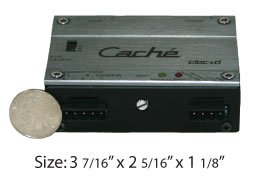 The local UPS driver and I are on a first name basis. I regularly get all kinds of audio gear sent to me for evaluation and testing from companies all over the world. And some of these cartons are really big, and really heavy. But a few days ago, a tiny little package arrived at the lab and knowing I had not ordered a pack of gum via UPS, I was mystified to find out what was inside. I cut the box open, and inside I found a product from a whole new company, called Caché. The Caché brand of audio equipment is a line of signal processors, converters, line drivers and bass restoration products. Specializing in 12 volt applications only, the product line consists of a half dozen pieces of gear designed to assist in OEM interfacing and system control and tuning.
The local UPS driver and I are on a first name basis. I regularly get all kinds of audio gear sent to me for evaluation and testing from companies all over the world. And some of these cartons are really big, and really heavy. But a few days ago, a tiny little package arrived at the lab and knowing I had not ordered a pack of gum via UPS, I was mystified to find out what was inside. I cut the box open, and inside I found a product from a whole new company, called Caché. The Caché brand of audio equipment is a line of signal processors, converters, line drivers and bass restoration products. Specializing in 12 volt applications only, the product line consists of a half dozen pieces of gear designed to assist in OEM interfacing and system control and tuning.To find out more about this new brand, and what they were all about, I spoke to the company’s president, Mike Morris, about the Caché products, and he told me, “We recognized the real need for products that exist to help dealers interface today’s aftermarket audio products with modern OEM sources, and to provide tuning ability and superior audio performance. For several years, we looked at the best the industry had to offer, talked to hundreds of dealers and installers, and then set out to build products with higher performance but at very competitive prices.”
The product they sent me to check out is their CLOC+D high level to RCA converter and line driver. Measuring only 3.5 inches square (including connectors) and about an inch high, the CLOC+D will easily fit into any tight space you might want to put it in. Very nicely finished with a black powdercoated housing and a CNC machined, brushed aluminum top cover, and with heavy-duty nickel plated panel mounted RCA outputs it gives the impression of being a high end product. The CLOC+D (Caché Line Output Converter+Driver) is designed to accept the high level (speaker) output of any OEM source unit or amplifier, and provide a high performance RCA level output signal. Or, it can also be used to simply convert a mediocre RCA signal to a truly high performance one. If you have an aftermarket source unit with low output voltage, and/or questionable source impedance, the line driver capability of the CLOC+D will transform that signal into something much superior.
Turn-on can be accomplished two ways, either by a traditional 12V trigger wire, or it has signal sense turn on capability for source units without a “trigger” lead. A separate 12V remote output connection is there to provide the trigger voltage required to turn on aftermarket amplifiers. The remote output function operates regardless of which method is used to turn on the CLOC+D.
The power and signal input connections are accomplished via a pair of quick disconnect multi-wire connectors. You insert the wires, tighten down the (tiny) screws, and then slide the connector in place. Controls are few and simple. There is a switch on the top of the unit to select either the high level inputs or the RCA inputs, and there is a gain pot mounted between the quick disconnect terminals to adjust the amount of available gain. A yellow “Maximum” LED will illuminate to indicate the onset of clipping, and a red Power LED lets you know the unit is turned on and passing signal.
I connected the CLOC+D to the speaker outputs of a radio on my test bench, and it turned on with the input signal very quickly, in less than a second. This quick turn on is a good thing, because it allows a stable signal to already be at the amplifiers inputs before it turns on, as most amplifiers have a few seconds of delay to prevent turn on pop noises. As the owner’s manual stated, the high level inputs will accept input signals up to 100 watts per channel. After playing with it for a few minutes, you know I took it apart. I was surprised to see the circuit density it has. (see photo) There are dozens of tiny very low tolerance surface mount devices inside, on a double sided fiberglass PCB. I connected it to my trusty Audio Precision analyzer to get the real numbers out of it, and see just how good it really was.
As it turned out, it’s pretty damn good. Using a balanced signal on the high level inputs, the CLOC+D delivered a maximum RCA output voltage of 10.4 volts, with a very low output impedance of 28 ohms. The RCA inputs will accept over 9 volts of signal without clipping, so the Caché piece is going to be compatible with any source unit or preamp. I measured the frequency response to be very flat as well, within 0.5dB from 20Hz to 20kHz. Signal to Noise measured better than -90dBA, and stereo separation was also excellent at better than -65dB. The voltage out of the remote output terminal did not drop much when compared to the supply voltage, (within 5%) which is important for amplifiers that need at least 11 volts to turn on.
Related Articles
 PASSWORD: JDM - Dry Carbon GT-R Parts
PASSWORD: JDM - Dry Carbon GT-R Parts
The Timeline:
Rewind about ten years ago and carbon fiber was for real race cars only. You almost needed an 8-figure budget just to get it right. If...
 Getting Hyphy: Calvin Wan's 1993 Mazda RX-7
Getting Hyphy: Calvin Wan's 1993 Mazda RX-7
Written by Dave Pankew |Photos by Chris Manacop (Cipher Media Group)
Ever noticed how a message can get totally lost in translation? Often it&...
 BIG BALLIN'
BIG BALLIN'
When Dan Quibell bought this full-size Denali in the summer of ‘04, and his original vision for it was not to transform it into the show-stopping,...
 Rugrat: Sean Driscoll's 2004 Scion xB
Rugrat: Sean Driscoll's 2004 Scion xB
Written by Dave Pankew | Photos by Edwin Villanueva
There isn’t much you can tell me about kids that I haven’t heard already....
 Project R32: Adjustable Suspension Links
Project R32: Adjustable Suspension Links
When ya wanna go fast, you have to look at every nut and bolt on your car. Because when you are piloting a chunk of steel and composites at unreal...
 Serge Leger's Team ETC 2009 Cadillac CTS
Serge Leger's Team ETC 2009 Cadillac CTS
Let’s face reality. The economy is headed into the toilet. For how long, no one knows but the fact is that all of these financial giants going under...




